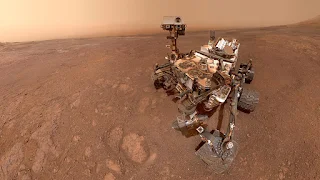NASA Curiosity Mars Rover performed the first gravimetric work on the surface of the Red Planet. Rover was able to determine the structure of the lower layers of Mount Sharp in the center of Gale’s crater. The studied soil was less dense than previously thought. According to scientists, this is strange, given the age of the deposits: the upper layers would inevitably pin down the lower ones. Experts came to the conclusion that Sharpe Mountain could have been formed from sand, which the wind gradually transferred to the center of the crater, while the uppermost layers at some point collapsed.
NASA Curiosity Mars Rover performed the first gravimetric work on the surface of the Red Planet. Rover was able to determine the structure of the lower layers of Mount Sharp – a multi-layered formation in the center of the 5.5 km high Gale crater.
Scientists have long been exploring the origin of this mountain. It is assumed that 3.5 billion years ago at the site of the crater there was a giant lake filled with water. Since the peak of Mount Sharpe rises above the edges of the crater, some researchers have suggested that the mountain was the result of sedimentation of the lake. Subsequent erosion exposed this sedimentary mass. Other experts believed that the mountain could have been formed due to the wind, and not water. The wind gradually transferred to the center of the crater stocks of sand.
During the new study, scientists found that the density of the lower layers of Mount Sharp is much lower than the expected values.
“Based on the data on the mineral content in rocks, we gave an estimate of the grain density of 2810 kg per 1 m³. However, the bulk density turned out to be much less – 1680 kg per 1 m³, ”said the author of the project, a graduate student of the Earth and Space Exploration School at Arizona State University, Travis Gabriel.
Curiosity landed on the surface of the Red Planet in 2012. On the 753rd day after landing, he reached the slopes of Mount Sharp. During this time, the rover managed to drive more than 350 m vertically. Much of the way Curiosity ran through the “Murray Formation”, which consists of sediments formed at the bottom of an ancient lake.
“We knew that the lower layers of the mountain were over time crushed by upper rocks. Because of this, the lower layers must be very dense. However, according to new data, they were not buried under a large amount of sediment, ”said study author Kevin Lewis from Johns Hopkins University.
Experts have concluded that Mount Sharpe could have been formed from sand, which the wind gradually transferred to the center of the crater. At the same time, the uppermost layers at some point collapsed. However, scientists noted that much about how these multilayered formations appeared and disappeared has yet to be learned.
NASA Curiosity Mars Rover performed the first gravimetric work on the surface of the Red Planet. Rover was able to determine the structure of the lower layers of Mount Sharp – a multi-layered formation in the center of the 5.5 km high Gale crater.
Scientists have long been exploring the origin of this mountain. It is assumed that 3.5 billion years ago at the site of the crater there was a giant lake filled with water. Since the peak of Mount Sharpe rises above the edges of the crater, some researchers have suggested that the mountain was the result of sedimentation of the lake. Subsequent erosion exposed this sedimentary mass. Other experts believed that the mountain could have been formed due to the wind, and not water. The wind gradually transferred to the center of the crater stocks of sand.
During the new study, scientists found that the density of the lower layers of Mount Sharp is much lower than the expected values.
“Based on the data on the mineral content in rocks, we gave an estimate of the grain density of 2810 kg per 1 m³. However, the bulk density turned out to be much less – 1680 kg per 1 m³, ”said the author of the project, a graduate student of the Earth and Space Exploration School at Arizona State University, Travis Gabriel.
Curiosity landed on the surface of the Red Planet in 2012. On the 753rd day after landing, he reached the slopes of Mount Sharp. During this time, the rover managed to drive more than 350 m vertically. Much of the way Curiosity ran through the “Murray Formation”, which consists of sediments formed at the bottom of an ancient lake.
“We knew that the lower layers of the mountain were over time crushed by upper rocks. Because of this, the lower layers must be very dense. However, according to new data, they were not buried under a large amount of sediment, ”said study author Kevin Lewis from Johns Hopkins University.
Experts have concluded that Mount Sharpe could have been formed from sand, which the wind gradually transferred to the center of the crater. At the same time, the uppermost layers at some point collapsed. However, scientists noted that much about how these multilayered formations appeared and disappeared has yet to be learned.
Tags
Space
